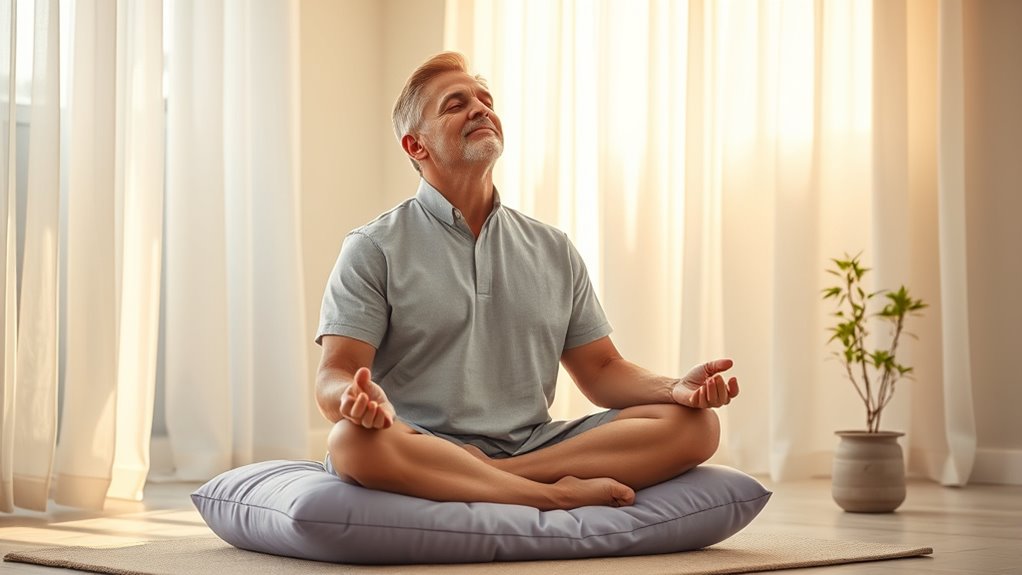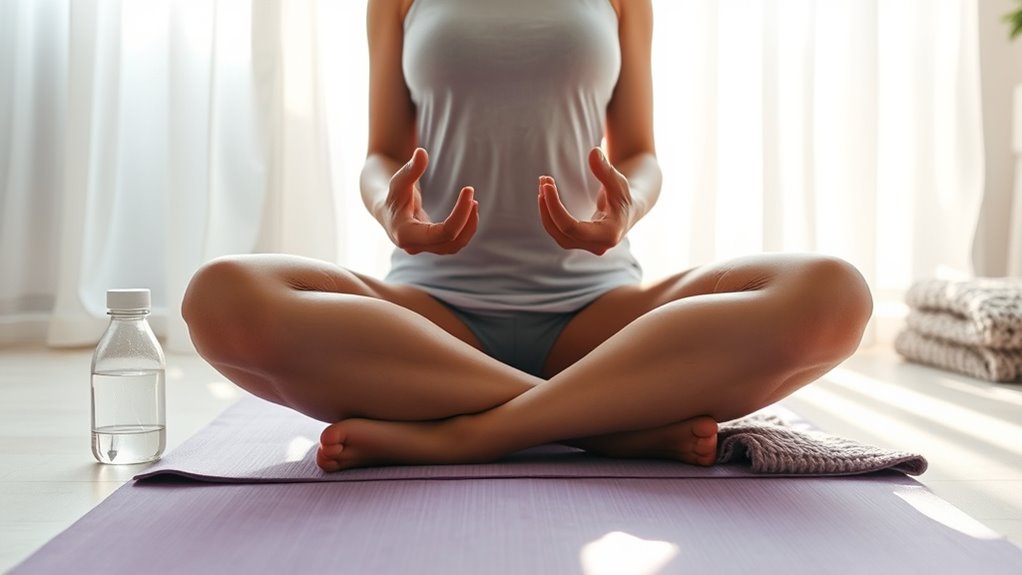A simple five-minute breathing exercise can help lower your blood pressure as much as some medications. By practicing deep, intentional breaths—like inhaling slowly through your nose, holding briefly, then exhaling calmly—you activate your body’s relaxation response. This helps reduce stress and calm your nervous system, leading to noticeable improvements in blood pressure. Keep practicing regularly, and you’ll discover more effective ways to manage your health and stay calm under pressure.
Key Takeaways
- A 5-minute breathing exercise activates the parasympathetic nervous system, promoting relaxation similar to medication effects.
- Deep, intentional breathing can lower blood pressure as effectively as some antihypertensive drugs.
- Regular practice reduces chronic stress, a major contributor to high blood pressure.
- Breathing exercises are quick, easy to incorporate, and can be done anytime to manage blood pressure spikes.
- Combining breathing with mindfulness and sound healing enhances overall stress reduction and blood pressure control.

Have you ever felt overwhelmed and needed a quick way to reset? When stress piles up, it can feel like your head is about to explode, and your blood pressure rises along with it. That’s where a simple 5-minute breathing exercise can make a real difference. By focusing on your breath, you tap into mindfulness meditation, helping you stay present and calm. This practice isn’t just about relaxation; it’s about actively reducing stress, which directly impacts your blood pressure. When you take a few moments to breathe deeply and intentionally, you signal your nervous system to shift from a stress response to a state of calm. This stress reduction is essential because chronic stress contributes profoundly to high blood pressure, and managing it can be as beneficial as medication for some people. Additionally, incorporating sound healing science techniques like calming sound frequencies can enhance the effectiveness of your stress management routine. Research shows that mindfulness practices cultivate a sense of awareness and resilience, making it easier to handle daily pressures with greater ease. Developing stress management skills through regular practice can lead to long-term health benefits and a better quality of life. Moreover, understanding the physiology behind your body’s response to stress can empower you to adopt healthier coping strategies. Engaging in deep breathing techniques has been shown to activate the parasympathetic nervous system, further promoting relaxation and lowering blood pressure.
Practicing this breathing exercise for just five minutes can lower your blood pressure as much as some medications, and the best part is, it’s effortless to incorporate into your daily routine. Find a quiet spot, sit comfortably, and close your eyes if you like. Inhale slowly through your nose, feeling your chest and belly rise as your lungs fill with air. Hold that breath for a second or two, then exhale slowly through your mouth or nose, consciously releasing tension. Repeat this cycle, focusing solely on your breath. As you do, you’ll notice your mind begins to quiet, and your body relaxes. This is mindfulness meditation at work—bringing your awareness to the present moment and letting go of worries. Over time, this practice helps you develop a greater sense of control over your stress levels, which is essential for long-term blood pressure management.
Frequently Asked Questions
Can Breathing Exercises Replace Blood Pressure Medications Entirely?
You’re wondering if breathing exercises can replace blood pressure medications entirely. While alternative therapies like breathing exercises and lifestyle modifications can substantially lower blood pressure, they may not be enough for everyone. It’s crucial to work with your healthcare provider to create a thorough plan. These techniques can complement your treatment, but don’t stop your medications without medical advice, especially if your blood pressure is very high.
Are There Any Risks or Side Effects to Doing This Breathing Exercise?
You might wonder if mindful breathing could have risks. While generally safe, rushing or holding your breath too long might cause dizziness or discomfort. The relaxation response from this exercise helps reduce stress, but if you experience chest pain or shortness of breath, stop immediately. Always listen to your body and consult a healthcare professional before making it a regular part of your routine. Stay cautious, stay safe.
How Often Should I Perform This Exercise to See Benefits?
You should aim for regular practice to see benefits. Generally, doing this breathing exercise once or twice daily is effective. Focus on maintaining a consistent practice frequency, ideally at the same times each day, to establish a routine. The most suitable timing depends on your schedule, but practicing in the morning or before bed can help maximize relaxation and blood pressure benefits. Keep it simple and consistent for the best results.
Is This Breathing Technique Suitable for All Age Groups?
Imagine a gentle river flowing smoothly—this breathing technique can suit many, but age considerations matter. If you’re young, it’s likely safe, yet older adults or those with physical limitations should consult a healthcare provider first. Just as every river’s course is unique, so is each person’s health. Adjustments may be needed, ensuring the practice remains a calming current rather than a force you can’t navigate.
Does This Method Work for All Types of Hypertension?
You wonder if this breathing method works for all types of hypertension. While it can help lower blood pressure, its effectiveness varies depending on your condition. For some, combining it with dietary restrictions and increased physical activity enhances results. However, if you have secondary hypertension caused by other health issues, you should consult your doctor first. This approach works best as part of a complete plan tailored to your specific needs.
Conclusion
You might think a quick breathing exercise can’t make a real difference, but just five minutes a day can lower your blood pressure as effectively as medication. It’s simple, drug-free, and easy to fit into your busy schedule. Don’t let skepticism hold you back—give it a try and see the benefits for yourself. With consistent practice, you could improve your health without side effects or extra pills. Why not start today?









